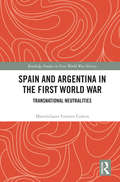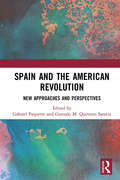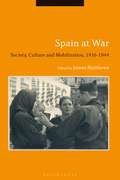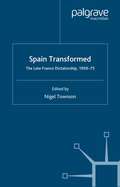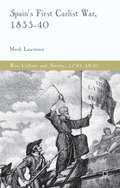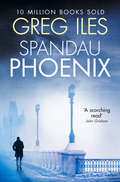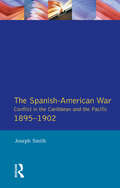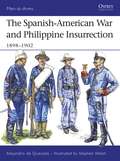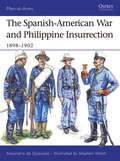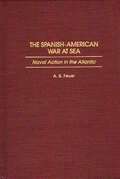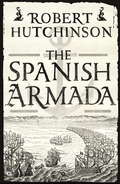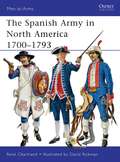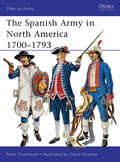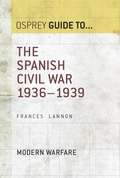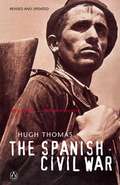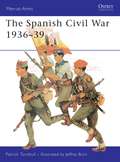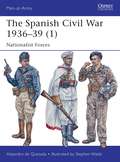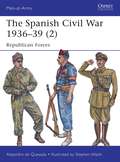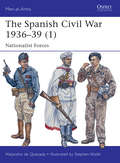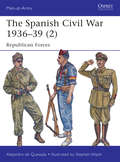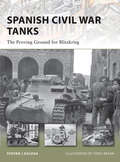- Table View
- List View
Spain and Argentina in the First World War: Transnational Neutralities (Routledge Studies in First World War History)
by Maximiliano Fuentes CoderaThis is the first book that analyzes the transnational impact of the Great War simultaneously on two countries, Spain and Argentina, that remained neutral throughout the conflict. Both countries were very relevant in the conception of propaganda and policies of belligerent countries such as France, Germany and Great Britain and showed that the conflict had a global influence and affected deeply local political and cultural processes, even in areas geographically distant from the trenches. Within this framework, this book is focused on three aspects that are analyzed dynamically throughout the whole war from a transnational perspective: neutrality as a space of dispute between pro-Allies and pro-German sectors and its relation with local politics, the debate about what positions should be assumed in order to guarantee a world without war, and the polemics on the ideas of nations and supra-nations (Hispanism, Latinism, Pan-Americanism). The conclusions of the book highlight that the radicalization that exploded in 1917 in both countries was fundamental in shaping the political radicalization of the last months of the conflict and the postwar period. As happened in Europe, the Great War did not finish in 1918 and its traces continued in the 1920s and 1930s.
Spain and the American Revolution: New Approaches and Perspectives
by Gabriel Paquette Gonzalo M. Quintero SaraviaThough the participation of France in the American Revolution is well established in the historiography, the role of Spain, France’s ally, is relatively understudied and underappreciated. Spain's involvement in the conflict formed part of a global struggle between empires and directly influenced the outcome of the clash between Britain and its North American colonists. Following the establishment of American independence, the Spanish empire became one of the nascent republic's most significant neighbors and, often illicitly, trading partners. Bringing together essays from a range of well-regarded historians, this volume contributes significantly to the international history of the Age of Atlantic Revolutions.
Spain and the American Revolution: New Approaches and Perspectives
by Gabriel Paquette Gonzalo M. Quintero SaraviaThough the participation of France in the American Revolution is well established in the historiography, the role of Spain, France’s ally, is relatively understudied and underappreciated. Spain's involvement in the conflict formed part of a global struggle between empires and directly influenced the outcome of the clash between Britain and its North American colonists. Following the establishment of American independence, the Spanish empire became one of the nascent republic's most significant neighbors and, often illicitly, trading partners. Bringing together essays from a range of well-regarded historians, this volume contributes significantly to the international history of the Age of Atlantic Revolutions.
Spain at War: Society, Culture and Mobilization, 1936-44
by James MatthewsSpain's principal and most devastating war during the 20th century was, unusually for most of Europe, an internal conflict. During the Spanish Civil War of 1936 to 1939 two competing armies – the insurgent and counterrevolutionary Nationalist Army and the Republican Popular Army – engaged in a conflict to impose their version of Spanish identity and the right to shape the country's future. In its aftermath, Francoist Spain remained on a war footing for the duration of the Second World War. In spite of the unabated flood of books on the Spanish Civil War and its consequences, historians of Spain in the 20th century have focused relatively little on the interaction of society and culture, and their roles in wartime mobilization. Spain at War addresses this omission through an examination of individual experiences of conflict and the mobilization of society. This edited volume acknowledges the agency of low-ranking individuals and the impact of their choices upon the historical processes that shaped the conflict and its aftermath. In doing so, this new military history provides a more complex and nuanced understanding of Spain's most intense period of wartime cultural mobilization between the years 1936 to 1944 and challenges traditional political accounts of the period.
Spain at War: Society, Culture and Mobilization, 1936-44
by James MatthewsSpain's principal and most devastating war during the 20th century was, unusually for most of Europe, an internal conflict. During the Spanish Civil War of 1936 to 1939 two competing armies – the insurgent and counterrevolutionary Nationalist Army and the Republican Popular Army – engaged in a conflict to impose their version of Spanish identity and the right to shape the country's future. In its aftermath, Francoist Spain remained on a war footing for the duration of the Second World War. In spite of the unabated flood of books on the Spanish Civil War and its consequences, historians of Spain in the 20th century have focused relatively little on the interaction of society and culture, and their roles in wartime mobilization. Spain at War addresses this omission through an examination of individual experiences of conflict and the mobilization of society. This edited volume acknowledges the agency of low-ranking individuals and the impact of their choices upon the historical processes that shaped the conflict and its aftermath. In doing so, this new military history provides a more complex and nuanced understanding of Spain's most intense period of wartime cultural mobilization between the years 1936 to 1944 and challenges traditional political accounts of the period.
Spain Transformed: The Franco Dictatorship, 1959-1975
by N. TownsonSpain Transformed addresses the sweeping social and cultural changes that characterized the late Franco regime. This wide-ranging collection reassesses the dictatorship's latter years by drawing on a wealth of new material and ideas, using an interdisciplinary approach.
Spain's First Carlist War, 1833-40 (War, Culture and Society, 1750-1850)
by M. LawrenceSpain's First Carlist War was an unlikely agent of modernity. It pitted town against country, subalterns against elites, and Europe's Liberal powers against Absolute Monarchies. This book traces the individual, collective and international experience of this conflict, giving equal attention to battle fronts and home fronts.
Spandau Phoenix (A\world War Ii Thriller Ser.)
by Greg IlesThe New York Times No.1 bestseller delivers ‘a scorching read’ (John Grisham). One of the great unsolved mysteries of World War II is – to some people – a secret worth killing for…
The Spanish-American War 1895-1902: Conflict in the Caribbean and the Pacific
by Joseph SmithFought in both Caribbean and Pacific and turning on America's superior naval strength, this short but decisive war had momentous consequences internationally. It ended Spain's imperial power, and the US emerged for the first time as an active force in world affairs, acquiring -- amidst much domestic controversy -- an empire of her own in the Philippines, Guam, Puerto Rico, and Cuba (whose struggle against Spain had sparked the war). Heavy with implications for twentieth-century America, the war is explored in its widest context in this engrossing and impressive study.
The Spanish-American War 1895-1902: Conflict in the Caribbean and the Pacific
by Joseph SmithFought in both Caribbean and Pacific and turning on America's superior naval strength, this short but decisive war had momentous consequences internationally. It ended Spain's imperial power, and the US emerged for the first time as an active force in world affairs, acquiring -- amidst much domestic controversy -- an empire of her own in the Philippines, Guam, Puerto Rico, and Cuba (whose struggle against Spain had sparked the war). Heavy with implications for twentieth-century America, the war is explored in its widest context in this engrossing and impressive study.
The Spanish-American War and Philippine Insurrection: 1898–1902 (Men-at-Arms)
by Stephen Walsh Alejandro De QuesadaThis book details the uniforms and weapons of the American, Spanish, Cuban and Filipino forces involved in the United States Army's first overseas war. In 1898 the USA took the decision to intervene in the Cuban war of independence against Spain, and to expel the last vestige of European colonial rule from the Americas. This also led to the US acquiring rule over the Philippine Islands; and there, US troops were sent into the jungle to fight a "colonial†? war of their own, against Filipino insurgents unwilling to exchange one master for another. The text is illustrated with rare early photographs and color plates.
The Spanish-American War and Philippine Insurrection: 1898–1902 (Men-at-Arms #437)
by Stephen Walsh Alejandro De QuesadaThis book details the uniforms and weapons of the American, Spanish, Cuban and Filipino forces involved in the United States Army's first overseas war. In 1898 the USA took the decision to intervene in the Cuban war of independence against Spain, and to expel the last vestige of European colonial rule from the Americas. This also led to the US acquiring rule over the Philippine Islands; and there, US troops were sent into the jungle to fight a "colonial†? war of their own, against Filipino insurgents unwilling to exchange one master for another. The text is illustrated with rare early photographs and color plates.
The Spanish-American War at Sea: Naval Action in the Atlantic (Non-ser.)
by A. B. FeuerBy piecing together diaries, letters, scrapbooks, and rare privately printed memoirs, the author has created a story which tells how America's ragtag navy—composed mainly of converted yachts, steamers and tugboats—was able to fight and win against the more powerful Spanish gunboats. The naval battles fought in places like Santiago, Cardenas, Cienfuegos, Manzanillo, Port Nipe, Guantanamo, San Juan, Guanica, and Ponce come alive in this book. The stories of the brave little ships that fought these battles—with names like the Gloucester and the Yosemite—at times against overwhelming odds, demonstrates the excellent training of the men who manned their guns under leadership of daring officers. This book fills in many of the missing pieces in the history of the Spanish-American War.
The Spanish Armada: A History
by Robert HutchinsonA dramatic blow-by-blow account of the defeat of the Spanish Armada by the English fleet - a tale of derring-do and disaster on the high seas by one of our best narrative historians.After the accession of Elizabeth I in 1558, Protestant England was beset by the hostile Catholic powers of Europe - not least Spain. In October 1585 King Philip II of Spain declared his intention to destroy Protestant England and began preparing invasion plans, leading to an intense intelligence war between the two countries, culminating in the dramatic sea battles of 1588.Robert Hutchinson's tautly written book is the first to examine this battle for intelligence, and uses everything from contemporary eye-witness accounts to papers held by the national archives in Spain and the UK to recount the dramatic battle that raged up the English Channel. Contrary to popular theory, the Armada was not defeated by superior English forces - in fact, Elizabeth I's parsimony meant that her ships had no munitions left by the time the Armada had fought its way up to the south coast of England. In reality it was a combination of inclement weather and bad luck that landed the killer blow on the Spanish forces, and of the 125 Spanish ships that set sail against England, only 60 limped home - the rest sunk or wrecked with barely a shot fired.
The Spanish Army in North America 1700–1793 (Men-at-Arms)
by David Rickman René ChartrandLong before England established a serious presence in the New World, Spain had already established an overseas Empire. In North America, this included vast tracts of territory including most of what today comprises the states of Florida, Arizona, Nevada, New Mexico, Texas, Alabama, Illinois and California. In later years, as the British and the French came to expand their claims, they often came into conflict with the Spanish. The Spanish also played a significant part during the American Revolution, fighting against the British and drawing off forces needed to fight the Americans. This book covers all of the North American Spanish forces that fought in the campaigns of the 18th century.
The Spanish Army in North America 1700–1793 (Men-at-Arms #475)
by David Rickman René ChartrandLong before England established a serious presence in the New World, Spain had already established an overseas Empire. In North America, this included vast tracts of territory including most of what today comprises the states of Florida, Arizona, Nevada, New Mexico, Texas, Alabama, Illinois and California. In later years, as the British and the French came to expand their claims, they often came into conflict with the Spanish. The Spanish also played a significant part during the American Revolution, fighting against the British and drawing off forces needed to fight the Americans. This book covers all of the North American Spanish forces that fought in the campaigns of the 18th century.
The Spanish Civil War: 1936–1939 (Guide to...)
by Frances LannonThe Spanish Civil War of 1936-39 was of enormous international as well as national significance. In this gripping volume, Frances Lannon explains how this internal conflict between democracy and its enemies escalated to involve Nazi Germany, Fascist Italy, and the Soviet Union. We go behind the scenes to find out the true story of the bitter fighting within the sides, not just between them. The experiences of the men and women caught up in the fighting are highlighted. For them, and for a world on the brink of the Second World War, the stakes were agonisingly high.
The Spanish Civil War: An Eyewitness Account Of The Spanish Civil War (Pelican Ser.)
by Hugh ThomasThough more than half a century has passed since the Spaish Civil War began in 1936, it is still the subject of intense controversy. What was it that roused left wing sympathisers from all over the world to fight for a cause for which their governments would not give active support? In his famous history, Hugh Thomas presents an objective analysis of a conflict - where fascism and democracy, communism and Christianity, centralism and regionalism were all at stake - and which was a much an international civil war as a Spanish one.
The Spanish Civil War 1936–39 (Men-at-Arms #74)
by Jeffrey Burn Patrick TurnbullBy the spring of 1936 an armed clash was imminent between the forces of Spain's extreme Left and extreme Right. Viewed largely as a confrontation between democracy and fascism, the resulting civil war proved to be of enormous international significance. Nazi Germany and Fascist Italy intervened to assist General Franco, while the Soviet Union came to the aid of the Republican forces. This book explains the background to the war and charts the course of the nearly three-year long conflict through to General Franco's victory. Photographs and colour plates illustrate the uniforms and equipment of the Republican and Nationalist armies.
The Spanish Civil War 1936–39 (Men-at-Arms #74)
by Patrick TurnbullBy the spring of 1936 an armed clash was imminent between the forces of Spain's extreme Left and extreme Right. Viewed largely as a confrontation between democracy and fascism, the resulting civil war proved to be of enormous international significance. Nazi Germany and Fascist Italy intervened to assist General Franco, while the Soviet Union came to the aid of the Republican forces. This book explains the background to the war and charts the course of the nearly three-year long conflict through to General Franco's victory. Photographs and colour plates illustrate the uniforms and equipment of the Republican and Nationalist armies.
The Spanish Civil War 1936–39: Nationalist Forces (Men-at-Arms)
by Stephen Walsh Alejandro De QuesadaThe Spanish Civil War, 1936–39, was the curtain-raiser to World War II, and the major international event of the 1930s. It was the first great clash of 20th-century ideologies, between the rebel Nationalist army led by General Franco (right-wing, and aided by Nazi Germany and Fascist Italy), and the Republican army of the government (left-wing, and aided by the Communist Soviet Union and many volunteers from liberal democracies). Three years of widespread campaigns involved the most modern weapons available. The war was fought ruthlessly by both sides, and when the Nationalists secured victory they installed a dictatorship that lasted until November 1975 – the last such regime in Western Europe. Featuring specially commissioned full-color artwork, this first part of a two-part study depicts the fighting men of the Nationalist forces that strove to take control of Spain alongside their German and Italian allies.
The Spanish Civil War 1936–39: Republican Forces (Men-at-Arms #498)
by Stephen Walsh Alejandro De QuesadaThe Spanish Civil War was the curtainraiser to World War II and involved a complex collection of forces, particularly on the Republican side. This title illustrates how diverse the Republican forces were, drawn from loyal elements of the Spanish army that rejected the appeal of the rebel generals, a wide range of volunteer regional units and political militias, and supported by volunteers from many other countries, including Great Britain, France and Germany, in units known as the International Brigades. The wide range of equipment and uniforms worn by these troops is revealed, as is, the organization of militias into conventional brigades and divisions. Featuring specially commissioned full-colour artwork, this second part of a two-part study depicts the fighting men of the Republican forces and examples of their foreign comrades.
The Spanish Civil War 1936–39: Nationalist Forces (Men-at-Arms #495)
by Stephen Walsh Alejandro De QuesadaThe Spanish Civil War, 1936–39, was the curtain-raiser to World War II, and the major international event of the 1930s. It was the first great clash of 20th-century ideologies, between the rebel Nationalist army led by General Franco (right-wing, and aided by Nazi Germany and Fascist Italy), and the Republican army of the government (left-wing, and aided by the Communist Soviet Union and many volunteers from liberal democracies). Three years of widespread campaigns involved the most modern weapons available. The war was fought ruthlessly by both sides, and when the Nationalists secured victory they installed a dictatorship that lasted until November 1975 – the last such regime in Western Europe. Featuring specially commissioned full-color artwork, this first part of a two-part study depicts the fighting men of the Nationalist forces that strove to take control of Spain alongside their German and Italian allies.
The Spanish Civil War 1936–39: Republican Forces (Men-at-Arms #498)
by Stephen Walsh Alejandro De QuesadaThe Spanish Civil War was the curtainraiser to World War II and involved a complex collection of forces, particularly on the Republican side. This title illustrates how diverse the Republican forces were, drawn from loyal elements of the Spanish army that rejected the appeal of the rebel generals, a wide range of volunteer regional units and political militias, and supported by volunteers from many other countries, including Great Britain, France and Germany, in units known as the International Brigades. The wide range of equipment and uniforms worn by these troops is revealed, as is, the organization of militias into conventional brigades and divisions. Featuring specially commissioned full-colour artwork, this second part of a two-part study depicts the fighting men of the Republican forces and examples of their foreign comrades.
Spanish Civil War Tanks: The Proving Ground for Blitzkrieg (New Vanguard #170)
by Steven J. ZalogaThe tanks used during the Spanish Civil War are not often examined in any great detail, and are often labeled as little more than test vehicles in a convenient proving ground before World War II. But, with groundbreaking research, armor expert Steven J Zaloga has taken a fresh look at the tanks deployed in Spain, examining how future tanks and armored tactics were shaped and honed by the crews' experiences, and how Germany was able to benefit from these lessons while their Soviet opponents were not. Based on recently uncovered records of Soviet tankers in Spain and rare archival accounts, this book describes the various tanks deployed in Spain, including the PzKpfw I and the T-26.
